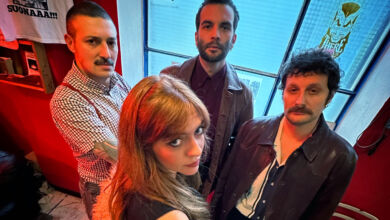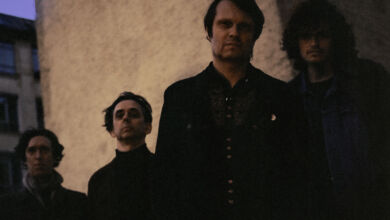
Marc Almond
Ten Plagues A Song Cycle
(Strike Force SFE034D)
Unlike many of his pop contemporaries, Marc Almond has never shied away from portraying art he considers resonant, important, or just plain worthy, and his ‘Ten Plagues’ song cycle is a case in point. Sung, accompanied only by piano played by Conor Mitchell, with libretto provided by Mark Ravenhill, the work is as stark as its source material.
Sung in the style of Brechtian cabaret, and set in the portentous year of 1665, it tells the story of a survivor and his journey through the living hell of plague-ridden London. The sombre piano notes of ‘Spring’ open our piece, soon turning to jittery chords as Marc describes the sealing of the city, to limit the contagion. The poignant image of an encounter with a priest who wants to preach, but has no congregation left stays in the mind long after the cycle is over. Marc’s stark delivery of lines like ‘Without a Word’ and the desperate protective spell of ‘Abracadabra’ reflect the depths the population sink to, lacking any hope of a cure.
The journey to a market, once brimming over with life and business, but now having neither, ironically has piano notes sounding like lapping water, and a comical feel to it, with its commerce-contagion central metaphor.
Short, stabbing chords, picked out like a bird pecking seeds from the ground, provides the chilling accompaniment to ‘The Pit’, a meditation on the signs of the plague and those who are unfortunate enough to display them. The piano chords become sweeter later on, a release. On/off chords turn into lapping water sounds once more, as our narrator finds plague signs on a lover, and in ‘A New Law’ we find a curfew being introduced, far too late for most it seems, and the mood turns ironically jolly again, as he sings from the point of view of an infected one.
‘Seeing you’ is a sublime tune, as our narrator rises and walks around the city, fires alight everywhere to purify the air. A surprisingly wistful song, even with the image of bodies being tossed into the pit. ‘The Wig’ has notes scattering like crazed insects across a page, with a tragi-comic story of a vain character who discovers that the hair on their beautiful wig was torn from plague victims, and carries the infection.
As the victims multiply, (‘Three thousand in two hours’) a hermit regrets not leaving the city, and starts to imagine the bleak future as the piano notes unwind like a ribbon. The shocking image of a former lover lying dead in the pit, and of a visitor from the country with no previous knowledge of the contagion, contribute to the oppressive atmosphere of the latter part of the cycle, which plays out like a new dance.
Besides the CD, a DVD of the live performance at Wilton’s Music Hall is included in this special edition, as starkly delivered in this bare theatre, as the music. Bearing the signs of one perhaps for Marc completists only, it’s time may yet come. BUY HERE!
TV Is the Thing
(Croydon Municipal CR9012)
Taking us on a nostalgia trip with a twist, those dedicated Silly Servants at Croydon Municipal have collected some of the most off-beat versions of 50’s and 60’s TV themes, peppered with bright, period advertising jingles, for their latest CD collection. The art of encapsulating the entire concept of a TV show in a short piece of music may be a rare instance of a required exact science in the otherwise fairly hit and miss world of television.
The sweet and rather suggestive title track is cheekily delivered by Dinah Washington, with a good, beaty feel to it, closely pursued by the standard spy-theme of Malcolm Lockyer’s ‘The Pursuers’, a full orchestra belting out a marching beat with plenty of rude, brassy horns and twangy guitars.
‘Route 66’ is put out with verve, excitement and class, that urgent, compelling beat held down perfectly by John Gregory. Gordon Franks’ ‘Outbreak of Murder’s shifting, wavering, moody jazz piece has an expertly picked guitar melody, suggestive of the murky alleyways and side streets where villains traditionally make their escape. Sasha Distel’s ‘Sasha’s Theme’ evokes the cocktail hour atmosphere well, with its glockenspiel, tish-taa cymbals and a little electric guitar for the moderns.
Charles Blackwell’s ‘Supercar’ is supremely beaty, with low bass guitar and horns rasping out, reminding us, with hindsight, of the Joe 90 theme, some years in the future. The Desperadoes’ ‘Cambridge Strings’ handles the classic Western formula of galloping drums and cymbals, hell for leather all the way.
It would be a peculiar album where Alan Ainsworth’s, wandering ‘Gurney Slade’ did not feel incongruous, the bare metronomic beat with haunting flute melody sounding like a theme for a slightly psychedelic spy film. The Ted Heath Orchestra’s ‘The Beat Way’ has a horn heavy, beaty and exciting feel, followed by two Cha-Cha treatments you’ll want to keep on playing all day for the sheer comic delight of it, the wildly popular ‘Z Cars’ theme, by the John Warren Orchestra, and ‘77 Sunset Strip’ by Pete Condoli and his Orchestra.
Jerry Allen’s ‘Lunchbox’ is a jaunty, happy piece, organ backing up the glockenspiel and cymbals, building well, and into Laurie Johnson’s ‘Las Vegas’, known better to millions of 60’s (and 70’s) kids as the joyous ‘Animal Magic’, here in its original, irreplaceable form. An excerpt from ‘Sooty’s Party’ will probably have the listener’s inner child on silliness overload at the sound of those velour animals’ beeps and groans. Popular singer Frankie Laine’s full throated version of ‘Champion the Wonder Horse’ will evoke memories for many, even though a cover of the original theme tune by the cruelly uncredited Mike Stewart.
John Barry’s presence is always welcome here, and his theme to ‘Dateline’, (Cutty Sark) has a smooth horn over a choppy beat, the rhythm getting tighter as the trombone kicks in. Alan Swain’s alt version of ‘Danger Man’ is a revelation, with its black-as-coal drums and wavering flute evoking the menacing air of a Soho, now sanitised.
Likewise, Johnny Dankworth’s ‘The Avengers’ plays fast and loose with the piece that is practically imprinted on the nation’s DNA, a smooth jazzy piece that is well worth persisting with.
John Gregory’s totally over the top ‘M Squad’ scores highly here, the horns’ throaty swagger, the confident, attention grabbing drums, and the honking boot sax make this a standout track.
The choice of Steve Stannard’s ‘Man of Mystery’ (theme from The Edgar Wallace Mysteries) over The Shadows better known top–two strings twanger is a bold move, the clarity and brightness to the guitar notes no less well played. Johnny Keating’s ‘Sam Benedict’ is a dark horse of a tune, poppy, and with a great bass, a strident tune with rock and roll leanings, reminiscent of ‘The Prisoner’ in its tenser moments.
Gordon Franks’ ‘Sid’s Theme’ (from Citizen James) is an unsurprisingly bright and jolly tune with a nod to the Hancock theme, a show James excelled in. Bryan Blackburn and Peter Evans’ ‘Eggheads’ is a slice of typical braggadocio humour, as our two protagonists impersonate a couple of intellectuals for fun, profit and making out with those kooky beatnik gals. Riotously funny lyrics and segueing into trad jazz at any provocation, a great piece of 50’s silliness. Craig Douglas’ ‘Chick Shape’ closes, and would be unlikely to win too many prizes for up to date attitudes to the ladies.
You’re going to buy this CD, you know you are, and you’re going to thank me for pointing this way. Cha Cha Cha. BUY HERE!
Goblin
Beyond the Darkness: (Bella Casa Casa 14CD)
Cineastes and soundtrack lovers alike will find plenty to enjoy on Bella Casa’s CD release of select extracts from the work of Goblin, whose four decade long career provided the eerily evocative, morosely moody and spine-chillingly sparse music of countless films by Italian Giallo/Horror master, Dario Argento.
Starting with ‘Buio Omega’ (‘Beyond the Darkness’) from 1979, the three excerpts run through a clanging guitar main title intro, segueing neatly into a rock and roll beat, road movie style, as if moving up and down the gears of a car. The icy cold piano notes over a ‘climbing the stairs’ run on ‘Quiet Drops’ could not be further away from the Caribbean stylings and call and response sequence in ‘Bikini Island’.
‘La Via Della Droga’ (‘The Heroin Busters’) theme from 1977 evokes the dark, dangerous alleyways with deft use of bass, tom toms and sharp notes stabbing like a burst of car headlights. The ever faithful ‘something bad is about to happen’ suspense notes make an early appearance, with synth, clattering and chanting, followed by a tense piece with a little relief later on.
‘Patrick’ (1979) has us on more familiar Argento ground, with ‘Transmute’, high pitched notes over a resounding bass guitar, the keyboards sounding like the glass elements of a chandelier clinking together, ‘Folie’, an excursion into the white noise spaces between radio stations, untrammelled runs up and down the keyboard, and sudden bass guitar interjections in a mad horseback ride of a piece. ‘Metamorfosi’s keyboard and sitar windings take us higher and higher, suggestive of rising smoke in some abandoned temple.
‘Squadra Antigangsters’ (‘Little Italy’) from 1979 opens with an alternate take of ‘Trumpet’s Flight’, its urgent bass run and fast and funky keyboards come out like a runaway train, the horn breaks suggestive of the high life enjoyed by the criminals, the main theme using liturgical organ that even manages to suggest ill-gotten luxury in amongst the devotional feeling.
‘Amo Non Amo’ (‘I love you, I love you not’) from 1979 has soothing strings and delicately picked acoustic guitar in its mournful love theme. ‘Funky Top’s cheerful bounce, winding guitar lick and sexy sax break does its job well, and the title track’s wistful yet cool piano figure is helped along with synth swishes, redolent of a fugitive love affair.
1980’s ‘Contamination’ has a nervous bongo intro in ‘The Carver’, as an urgent piano turns swiftly to a rock bass riff with reeling, frightening chords that still manage to suggest dance rhythms in amongst the cold terrors. ‘Time Is On’s skeletal glockenspiel, shrieking seagulls and wavering , meandering rhythm leave you breathless, and ‘Withy’s echoing feel, with manic guitar picking over a weird organ sound provides the most atmospheric piece so far, building tension well, to a little psyche-lite, ending on a tense chord.
‘1983’s ‘Notturno’ (‘Spy Connection’) has stabbing piano chords over an exciting organ wash, an excellent could’ve-been James Bond theme, taking us into ‘Bass Theme’, a more stereotypical spy film treatment, with bongos, strings and bass, taking a surprise turn later, into a ‘hurdy gurdy’ type rhythm. ’Landing Strip’s urgent, if sparse piece has some expert feedback, and ‘Helicopter’ starts with the expected choppy sound, leading into a slow, soothing keyboard piece.
‘Phenomena’ (1985) opens with ‘Jennifer’s light touch keyboard, prettily suggestive of innocence, later introducing tension in a fuzzy psychedelic guitar riff. ‘Phenomena’s baroque, spiky notes with eerily ghostly singing and rising and falling chords is a standout track, perfectly suited to the classic film of the title.
‘La Chiesa’ (‘The Church’, from 1988) opens with ‘Lotte’s macabre feel, suggestive of the presence of a malign spirit, is expertly evoked here, the high piping noises and spidery notes behind, suddenly turn to a hellish maelstrom of drums and organ, running away in fear, horns blaring like banshees.
’Non Ho Sonno’ (‘Sleepless’, from 2001) has ‘Arpeggio’s hard rock feel, short, sharp, punky guitar chords and ghostly keyboards strokes, which later become a deeper, more rounded piece, with a touch of the fearful hidden
in its depths. BUY HERE!










